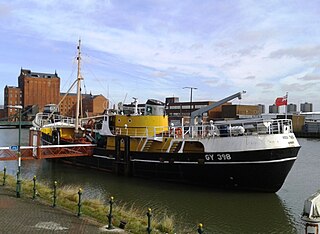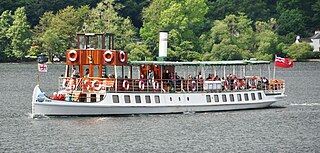
A fishing trawler is a commercial fishing vessel designed to operate fishing trawls. Trawling is a method of fishing that involves actively dragging or pulling a trawl through the water behind one or more trawlers. Trawls are fishing nets that are pulled along the bottom of the sea or in midwater at a specified depth. A trawler may also operate two or more trawl nets simultaneously.

The Arctic Corsair(H320) is a deep-sea trawler, built in 1960, that was converted to a museum ship in 1999. She is temporarily berthed at Alexandra Dock in Kingston upon Hull, England, pending completion of a new permanent location in the city's Museums Quarter. Exhibits and guides aboard the boat tell the story of Hull's deep-sea fishing industry.

Granton is a district in the north of Edinburgh, Scotland. Granton forms part of Edinburgh's waterfront along the Firth of Forth and is, historically, an industrial area having a large harbour. Granton is part of Edinburgh's large scale waterfront regeneration programme.

Seafield is a coastal strip situated on the Firth of Forth between Leith and Portobello in north-east Edinburgh, Scotland. The area is mainly commercial, and has little housing.

PS Lincoln Castle was a coal-fired side-wheel paddle steamer, which ferried passengers across the Humber from the 1941 until 1978. She was the last coal-fired paddle steamer still in regular services in the UK. Later, she served as a pub at Hessle, and then as a restaurant under permanent dock at Alexandra Dock, Grimsby. In September 2010, the Hull Daily Mail reported that she was in an advanced state of demolition, despite the efforts of local people to buy the historic vessel and restore her. On 31 March 2011, the Lincoln Castle Preservation Society were reported to have purchased the broken up parts of the ship for restoration.

A fishing vessel is a boat or ship used to catch fish and other valuable nektonic aquatic animals in the sea, lake or river. Humans have used different kinds of surface vessels in commercial, artisanal and recreational fishing.

Hall, Russell & Company, Limited was a shipbuilder based in Aberdeen, Scotland.

HMS Natal was a Warrior-class armoured cruiser built for the Royal Navy in the first decade of the 20th century. She escorted the royal yacht in 1911–1912 for the newly crowned King George V's trip to India to attend the Delhi Durbar. During World War I the ship was assigned to the 2nd Cruiser Squadron of the Grand Fleet, but did not participate in any battles. Natal was sunk by an internal explosion near Cromarty on 30 December 1915 with the loss of at least 390 crewmen and civilians. Most of her wreck was slowly salvaged over the decades until the remnants were demolished in the 1970s so they were no longer a hazard to navigation. The remains of her wreck are designated as a controlled site under the Protection of Military Remains Act 1986 as a war grave.

A steam yacht is a class of luxury or commercial yacht with primary or secondary steam propulsion in addition to the sails usually carried by yachts.

The ST Leukos was an Irish commercial trawler that was sunk off the coast off the north coast of Ireland by a German U-boat on 9 March 1940. The vessel, which had been fishing in the company of British trawlers, was attacked by the German submarine U-38 off Tory Island. The submarine surfaced opening fire with its deck gun. All 11 crew members were lost.

The Viola is a steam trawler built in 1906 in Hull. She is the oldest surviving steam trawler in the world. During her long career, she was known as HMTViola, Kapduen, and Dias. She is currently beached at Grytviken in South Georgia, though there are currently plans afoot to return her to Hull.

Aberdeen Harbour, rebranded as the Port of Aberdeen in 2022, is a sea port located in the city of Aberdeen on the east coast of Scotland. The port was first established in 1136 and has been continually redeveloped over the centuries to provide a base for significant fishing and ship building industries. Since the 1970s it has provided support to the offshore oil and gas industry operating in the North Sea and it is the main commercial port in the north east of Scotland.
The Maritime history of Scotland involves events including shipping, ports, navigation, and seamen, as well as marine sciences, exploration, trade, and maritime themes in the arts of Scotland.

Ross Tiger is a traditional side-winder fishing trawler that was converted into a museum ship in 1992. She is currently berthed in Alexandra Dock at her home port of Grimsby, close to the site of the former PS Lincoln Castle. She forms the star attraction of North East Lincolnshire County Council's National Fishing Heritage Centre since restored and opened to the public in 1992. As Grimsby's last traditional sidewinder 'conventional trawler', she represents a now virtually extinct breed of vessels that once made up the largest fishing fleet in the world.

The SS South Steyne is a former Manly ferry on Sydney Harbour. She was the world's largest steam-powered passenger ferry and operated on the service from 1938 to 1974. Restored in the 1980s, she served as a restaurant ship in Newcastle in the 1990s, and in 2000 was moved back to Sydney and open to the public at Darling Harbour. Since April 2016 she has been stored at Berrys Bay. She was added to the New South Wales State Heritage Register on 2 April 1999.

Excelsior is an authentically restored fishing smack of the Lowestoft fishing fleet and a member of the National Historic Fleet. She was built by John Chambers of Lowestoft in 1921 and worked until 1936 before being converted into a motor coaster.</ref> In 2021 Excelsior will celebrate her 100th birthday. During her time as a motor coaster she was known as Svinør and worked mainly in Norwegian waters before returning to Lowestoft in 1972.

RNLB Emma Constance was a Barnett-class lifeboat stationed at Aberdeen Lifeboat Station, in the Scottish city of Aberdeen from 1927 until August 1951. The lifeboat was designed by James R. Barnett who was a consulting naval architect to the Royal National Lifeboat Institution (RNLI).
Empire Fisher was a 268 GRT trawler that was built as Herrlichkeit in 1922 by Reiherstieg Schiffswerfte & Maschinenfabrik, Hamburg, Germany for the Nordsee Deutsche Hochsee Fischerei Bremen-Cuxhaven AG. She was captured in 1940 by HMS Glasgow, passed to the Ministry of War Transport (MoWT) and renamed Empire Fisher. She was sold in 1948. Sold for scrapping in 1952, she was resold to Ireland and scrapped later that year.

SY Tern, now operating as MY Tern, is a passenger vessel on Windermere, England. Launched in 1891 she was built for the steamer service carrying passengers from the Furness Railway. She underwent several changes in owner as companies were merged throughout the twentieth century, and spent time as a sea cadet training ship during the Second World War. Refitted several times, her original steam engines have been replaced with diesel engines. Tern is the oldest vessel operating on Windermere, and is a member of the National Historic Fleet. She is currently operated by Windermere Lake Cruises as the flagship of their fleet.
SS Ben Doran was a steam fishing trawler that operated out of Aberdeen, Scotland. It was launched in 1900 and operated until its wrecking on the Ve Skerries, Shetland, on 29 March 1930, which claimed the lives of the full crew, believed to number nine crew members. Its wrecking has been called "the most tragic wreck in all Shetland's history".

















